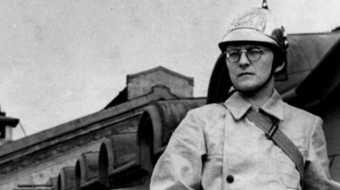
Recently, Planned Parenthood took steps to publicly disavow their founder, Margaret Sanger. The organization announced it was removing her name from a clinic in Manhattan, citing her support for eugenics. This decision has not satisfied right-wing “right to lifers” who continue to attack Planned Parenthood, but it has garnered support from pro-choice, anti-racist activists, who argue that, because she had views on eugenics that were as wrong then as they are now, she has become a hindrance in the effort to outreach to women of color.
The disavowal comes in the wake of a movement to take down the statues and monuments to U.S. Civil War Confederates and their pro-slavery supporters.
Allegations about Sanger’s racism have been made for many years, and it is not surprising that Planned Parenthood, under sharp attack as it is from the right, would try to take this issue away from those who use it hypocritically to hurt the organization. The right wing, not known for its opposition to racist ideology, has been attacking Planned Parenthood by characterizing its founder as a racist advocate of eugenics.
It is also understandable that Planned Parenthood would make the move to drop Sanger’s name from a building at a time when progressive, anti-racist forces are on the move like never before. No person of good will can deny Planned Parenthood and its good work needs all the support it can get.
History is complicated, however, and it is unfortunate that in disavowing Sanger, Planned Parenthood has not pointed out that there are major parts of her life that deserve praise and are well worth remembering. I speak, in particular, of the tremendous contributions she made to both the labor and feminist movements.
At a time today when the working class is deeper in disarray—having suffered successive, regressive setbacks since the post-WWII anti-communist years, the Reagan/Thatcher attacks against labor unions in the 1980s, the destruction of the USSR in 1991, and now the calamity of the COVID-19 pandemic—we should not forget the contributions made by effective labor and feminist leaders in the past.
While Sanger did have ideas we find intolerable today, bigotry and contempt for workers were not among them.
For almost 25 years before she founded Planned Parenthood with her sister, Ethel Byrne, and a small group of radicals, Sanger was an early Socialist Party USA member and an organizer for the Industrial Workers of the World. Another famous organizer for the IWW at the time was Elizabeth Gurley Flynn, future chair of the Communist Party USA.
It was witnessing the effect the labor struggle had on the wives and children that caught Sanger’s attention over time. As she details in her memoir, Pivot of Civilization: “We saw that in the final analysis the real burden of industrial warfare was thrust upon the frail, all-too-frail shoulders of the children….” She writes that her concerns were rebuffed by a mostly male labor leadership. She wanted to encourage these families to limit the number of hungry children they were producing. Some labor leaders, radicals among them, had actually argued at the time that the more poor we had, the sooner the proletarian revolution would come. Others, of course, fell into the opportunist position that feminist concerns would divert from the class issues facing all workers.
Also, some in the male leadership of labor movements didn’t like Sanger’s challenge to patriarchy. Her frequent counsel to women that they listen to themselves before they listen to their husbands did not go over well with some of the husbands.

Interestingly, as her disaffection grew with some of the male leaders with whom she worked, she began reading writers like Karl Kautsky, Rudolf Rocker, Lorenzo Portet, Francisco Ferrer, and Enrico Malatesta. Sanger writes in her memoir how these thinkers “encouraged and strengthened” her. Of these, she cites Rocker, the anarcho-syndicalist, most of all.
While some of these writers were out of favor with some of the labor leaders of the day, none were in the camp of the racists or eugenicists.
It is well known that the Nazis later adopted their ideas on race from American eugenicists. When they notoriously burned books, the works of Margaret Sanger were included among those tossed into the flames. They did not like the fact that she had written that birth control aimed at making life better for women and that it was absolutely intolerable to use it to reduce the numbers of people in so-called inferior races or the members of minority religious groups.
Sanger’s separation from the IWW widened when she and her sister started smuggling in contraceptive devices from the UK. This brought the Planned Parenthood founder not only on a collision course with some of the labor leadership of her day but also with many state laws that prohibited possessing, teaching, or disseminating contraceptives. Connecticut was just one of these states.
By 1920, the “pivot” from full-time labor organizer to birth-control advocate was complete. Sanger had always been a feminist and suffragette, and these impulses equally drove her labor organizing as well as her establishment of Planned Parenthood. Sanger the IWW labor organizer did formally break with the union and was solidifying the concept of Planned Parenthood “clinics,” but in her mind, at least, it was part of the same cause of women’s liberation. The clinics would provide women contraception, teach techniques to avoid pregnancy, and nurture the idea that women as autonomous beings needn’t listen to their husbands.
At Sanger’s direction, drawing from her years as a labor organizer, the clinics were integrated with Black and white staff—nurses and doctors.
In establishing these clinics, she had not only the support of many white women, like Flynn of the Communist Party, who counted among her financial and activist supporters but also the NAACP co-founder W.E.B. Du Bois, Paul Robeson, Rep. Adam Clayton Powell, Mary McCloud Bethune, and some pro-labor activist Black ministers who would eventually invite Sanger to come and speak to their congregations.
Du Bois sat on the board of Planned Parenthood. In later years, Rev. Martin Luther King, Jr., praised her work—and became the recipient of the organization’s first award.
Du Bois and those Black ministers’ support is important. It was in a 1939 correspondence with one of her friends that a passage has been taken out of context to haunt Sanger ever since. She wrote: “… We do not want word to go out that we want to exterminate the Negro population, and the [Black] minister is the man who can straighten out that idea if it ever occurs to any of their more rebellious members….” She was discussing her visits with some Black church congregations.
Her words were chopped down and manipulated to: “We do not want word to go out that we want to exterminate the Negro population.” This dishonest excerpting is offered as proof of her supposedly racist beliefs.
Challenged once to explain her stance on eugenics, Sanger was clear: “If by ‘unfit’ is meant the physical or mental defects of a human being, that is an admirable gesture, but if ‘unfit’ refers to races or religions, then that is another matter, which I frankly deplore,” she said in 1934.

Admittedly, even Sanger’s qualification for “physical and mental defects” is abhorrent today, but our evolved social attitudes toward the disabled or physically challenged are barely 30 years old, dating back to the 1990s Americans with Disabilities Act and slightly earlier struggles in public education to provide schooling for all children. Further, I argue her use of the term “racial betterment” in her memoir, writings, and speeches—even to Black congregations—bears the broader connotation of the human race, not a narrow ethnic one.
Other racist quotes attributed to Sanger have been dispelled by scholars like Marxist historian Silvia Federici and Charles Valenza.
Federici’s effort to rehabilitate Sanger extends to such works as Caliban and the Witch: Woman, the Body, and Primitive Accumulation, where she discussed the overarching problem Sanger and women like her face. In an interview in a 2012 issue of the journal Race, Poverty & the Environment, she said, “As we learned in the feminist movement, often the first obstacle a woman encounters when she wants to make a fight is not directly the state but the man in the family.”
Valenza’s research, meanwhile, found that the racist quotes attributed to Sanger were not hers but did appear in a magazine she founded but which was later under the editorial control of others. Nevertheless, in a 1985 article, “Was Margaret Sanger a racist?,” that appeared in Family Planning Perspectives, Valenza argues these disparate authors appeared in her birth-control journal due to their name recognition at the time, and Sanger was interested in raising money for her cause not because she endorsed their ideas.
Lastly, I mentioned Connecticut, the locale of Sanger’s first clinic. New York and Maryland would follow. Sanger’s friend and Planned Parenthood co-founder, Katharine “Kit” Hepburn (mother of the actress), a Communist, helped organize the Connecticut clinic. Hepburn’s sister, Edith Hooker, organized the first one in Baltimore.
The Connecticut clinic was chosen early on by Sanger as the site to test the anti-contraception laws, test cases which culminated in the U.S. Supreme Court’s 1965 Griswold v. Connecticut decision, which not only established a “right to privacy” but also became the foundation of the Roe v. Wade decision, the overturning of anti-gay sodomy statutes, and, lately, the right of lesbian and gay marriage.

Sanger died shortly after Griswold in 1966.
The sum of Sanger’s lifetime of struggle and the allies and friends she attracted do not add up to a white racist or a eugenicist.
Sanger is not the real target of the right wing, however. It is women’s sovereignty over their own bodies that the right wing and patriarchy find objectionable.
In fact, this right wing which has attacked her for so long scarcely knows her: It’s news to anti-abortionists who despise Sanger that Planned Parenthood did not begin providing abortion services until 1973, several years after her death.
And today, as Planned Parenthood disavows its founder, this same right wing seeks to capitalize on an anti-racist narrative in which they have no street credentials whatsoever. They want to take down a hundred-year-old organization which has not only served its main constituency of working-class women but also goes largely unrecognized for the health services it provided to gay men during the AIDS pandemic.
The left must be smart. Who thinks the right will be satisfied now that Sanger’s name has been publicly disavowed? Who thinks the mission of Planned Parenthood will now be freed to do its work? The right is chipping away at the foundations of our radical history, and we must not cede ideological ground to them.
As with all op-eds published by People’s World, this article reflects the opinions of its author.










